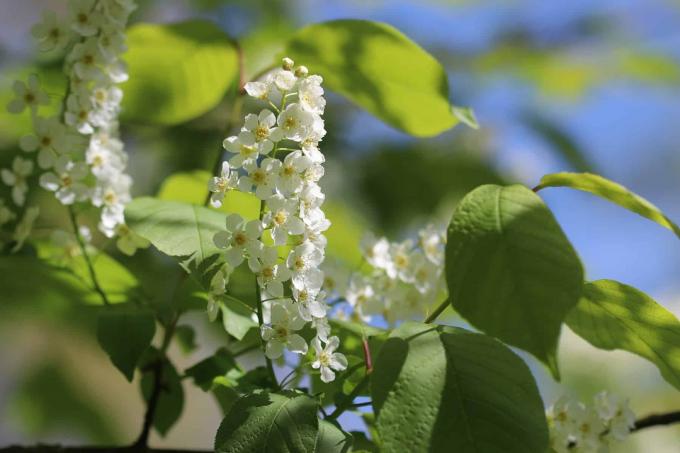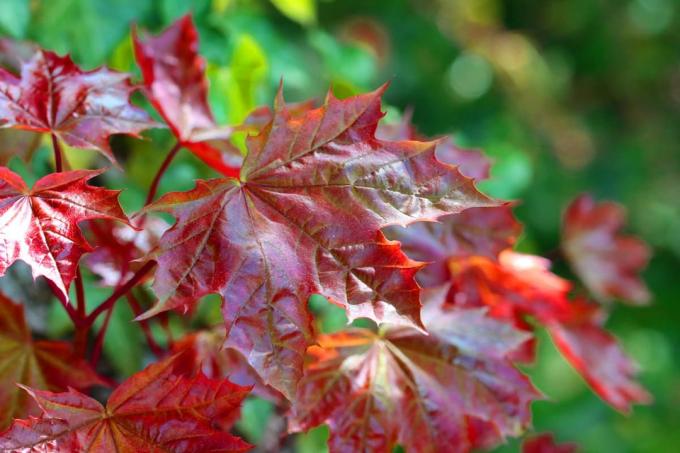

Table of contents
- Characteristics
- heyday and blossoms
- soil conditions and location
- fertilizing and watering
- harvest time
- toxicity
- diseases and pests
- Plant
- Cut
- hibernate
- multiply
The bird cherry is particularly popular in semi-natural gardens, as it is on the one hand during the long flowering period around a bee pasture and on the other hand during the harvest season around a tree with valuable fruit for birds acts.
Characteristics
- bot. Name Prunus padus
- The rose family (Rosaceae)
- other names marsh or awl cherry
- white flower clusters from April to June
- Growth type Large shrub or small tree
- multi-stemmed and overhanging
- up to 15 meters high and 8 meters wide
- sensitive to lime
Poisonous plant for children, horses and other animals - Confusion with highly toxic American bird cherry (Prunus serotina)
heyday and blossoms
From April to June, the long flower clusters form on Prunus Padus, hanging from each cluster here up to thirty white flowers, which look very decorative, but also have both disadvantages and advantages offer:
- strong to unpleasant smell
- ideally not planted near a seat
- rich in nectar and pollen
- attract bees, moths and hoverflies
A notice:
The bird cherry owes its name to its flower clusters and the later developing cherry-like drupes.

soil conditions and location
In its natural environment, Prunus padus grows at the edges of water bodies, at the edge of forests and in sparse alluvial forests. At the location in the garden, the plant can be cultivated both as a solitary plant but also with sufficient distance in a hedge:
- little light requirement
- Partial shade or even shade desired
- like to be near water
- Soil should be moist and fresh
- nutritious
- Enrich with compost before planting
- Marsh soil such as loam or clay is ideal
- lime intolerant
- Avoid drought
Tip:
The wide shrub is also so well suited for colorful hedge cultivation because it not only gives the birds food, but also enough space and rest to build their nests.
fertilizing and watering
Bird cherries have a very high water requirement. Therefore, they have to be watered regularly and a lot, especially on very hot days:
- Soak the soil well
- ideally in the early morning or late evening hours
- water daily during dry periods
- Use rainwater due to lime intolerance
- Tap water must be stale
- Fertilize once in spring
- Fold in the compost and horn shavings
- alternatively give long-term fertilizers such as blue grain
- regular mulching helps prevent moisture loss and fertilizes at the same time

harvest time
In September, the bird cherry develops first red then black drupes, which are very popular with birds. Since the fruits are not poisonous and can even be eaten, they can also be used in the kitchen:
- bittersweet to tart taste
- can be processed
- are suitable for juice, jelly or vinegar
- Caution star core is slightly poisonous
- contains a small amount of hydrocyanic acid
A notice:
The seeds can be distributed by the birds in the garden and the wider area and Prunus padus can multiply unintentionally as a result.
toxicity
If there are small children or horses in the garden environment, the cultivation of the bird cherry should be avoided. The taste of the poisonous parts is so unpleasant for both children and animals that they are usually spat out immediately. Nevertheless, caution should be exercised:
- bitter sour aroma
- in bark and all other plant parts
- toxic prussic acid glycoside
- decomposes in connection with water to bitter almond oil and hydrocyanic acid
- kernels are also poisonous
- contain hydrocyanic acid like apricot kernels
- should not be swallowed with the non-toxic fruits
The American bird cherry (Prunus serotina) is also more dangerous when confused, but in contrast to the plant that lives here, it is not cultivated and is more likely to be fought. Because this bird cherry species splits off highly toxic hydrocyanic acid from all parts of the plant and the Consumption can certainly lead to symptoms of poisoning, there is no confusion between the two types rarely.
Tip:
However, you don't have to worry too much about your children or animals if you have cultivated Prunus padus in the garden. Because the seeds in the fruit are so large that they are usually not accidentally swallowed.
diseases and pests
Even if the bird cherry is considered to be quite robust, it is not completely spared from pests and diseases. In this way, a tree can be completely spun around by the spider moth. The larvae feed on the leaves and can almost bare the plant. However, Prunus padus recovers from this quite quickly and sprout again. In addition, the birds are happy about the food source, so this problem usually solves itself. There are other diseases and pests that can attack the plant:
- scab
- leaf spot disease
- brown rot
- all fungal diseases
- treat it with fungicides
- remove all affected twigs and branches
- aphids and fruit flies
- spray with a hard jet of water
- several days in a row
Tip:
So that the plant is better protected against diseases and pest infestation, care mistakes should be avoided. These include a wrong dark location, too dry but also waterlogging as well as a calcareous and too heavy soil.

Plant
It is ideal if the shrub is planted in autumn. It is already important here to stop the very sprawling growth and to create a root barrier so that it cannot also spread underground. For this purpose, a dense network must be used around the root ball, which the roots cannot penetrate:
- Prepare soil with compost and horn shavings
- Planting hole twice as big as root ball
- Submerge bales completely in water
- drainage is not necessary
- use support with young plants
- insert plant
- fill in soil
- press well
- pour on
Tip:
If you create a hedge with several plants, make sure you leave enough space now. Prunus padus also grows in width, so that opaque hedges can quickly be created even with larger planting distances. You should keep a planting distance of one to two meters.
Cut
Pruning the bird cherry is essential because the shrub grows sprawling and fast. It is particularly important to note the right timing. Just once a year is by no means enough to keep the bird cherry small, because it grows almost 80 centimeters in one year. Depending on whether it is a hedge plant or a solitaire, the cut must be proceeded accordingly:
- cut in late winter between February and March
- choose a frost-free, dry and overcast day
- a second time in the fall
- Cut hedge in height
- Thin out the tree or shrub
- remove damaged and dead wood
- also vertically growing or crossing shoots
- cut the crown of a tree into a corresponding shape
- always cut at an angle over an outwardly protruding eye
- always use sharp and clean tools
If the crown of a Prunus padus growing as a tree is permeable and even after cutting, then this is quite sufficient. The hedge is also slightly permeable again after the cut, but will grow back opaque again in a short time.
A notice:
If no root barrier has been set up, you must also remove the side root shoots with regular pruning. Do not put these in the compost, otherwise new bird cherries could grow from them. It is better to dispose of the roots in the residual waste.
hibernate
The older plants of the bird cherry survive the winter, even if it is very cold, but without any protection, a layer of mulch can be laid around the trunk over the roots. However, the young plants that have just been cultivated should be protected from severe frost in the first winter:
- Lay brushwood or leaves over root ball on soil
- Cover the crown with plant fleece
- cover newly created hedges with plant fleece
- Don't forget to water even in winter
- water in dry periods on frost-free days
A notice:
It is more likely that Prunus padus will dry up in a winter when there is no rain for a long time than that the crop will die from frost damage.

multiply
Propagating bird cherries is easy with cuttings. This type of propagation is particularly useful if the plants are to form a hedge. Because the fast-growing shrubs can form a dense hedge with the cuttings within a short time of two to three years. But a solitaire can also be grown from cuttings:
- use sticks
- these are hard shoots
- cut between fall and winter
- Use shoots about 40 centimeters long
- three leaf knots on each stick make sense
- put in pots with potting soil
- a leaf knot underground
- put in a bright, warm place
- Windowsill or greenhouse is ideal
- keep moist
Once the rooting has taken place, the small young plants can be planted directly outdoors in the spring at the desired location. Alternatively, cuttings with leaves can also be used in spring, which are used in the same way. When the first new leaves appear, they are also placed outdoors.
A notice:
The day you cut the cuttings should be frost-free, dry and overcast. Then the interfaces on the plant can best heal and close without the plant itself being damaged.
 garden editorial
garden editorial I write about everything that interests me in my garden.
Learn more about Baumlexikon

Red maple: 9 tips for caring for, cutting & overwintering
The red maple is one of the most impressive trees in Germany due to its unusual scarlet leaf colour. Here you can find out how to integrate this impressive plant into your garden and how to keep it healthy and vigorous.

Sycamore tree: Properly care for and cut sycamore trees
The plane tree (Platanus) has a high decorative value. In terms of care, it is mostly undemanding, which is why it is often chosen as a street tree. Nevertheless, there are a few details to be observed when it comes to care, as described in the home garden guide.

Birch locations: 5 important criteria
Birch trees are extremely frugal trees and are particularly eye-catching and decorative thanks to their light-colored bark. When choosing a location, however, a few factors should be considered in order to create optimal conditions for their growth and to protect the environment.

Cutting dwarf pine - instructions for the perfect cut
Dwarf pines can be pruned by thinning out, topiary or limbing. A bonsai design with needle and root pruning is also possible. So that the wood does not look unattractive after the pruning measure, a few rules of technology should be observed.

Is the vinegar tree poisonous? | Who is it dangerous for?
In ornamental gardens, the vinegar tree is an attractive eye-catcher due to its unusual flowers and the appealing autumn color of its feathered leaves. The red, upright fruit cobs (flowers) are responsible for the striking appearance. Despite everything, the vinegar tree is not an unproblematic tree.

Vinegar, Rhus typhina | Care from A – Z
The vinegar tree is an easy-care plant for the garden and tub with a special autumn color. Only its uncontrolled spread can lead to problems in the garden. However, this can be curbed with a root barrier.



